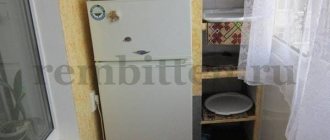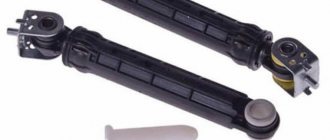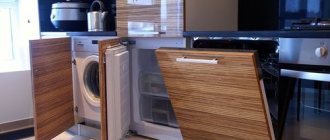It just so happens that the majority of the population of our country lives in “Khrushchev” buildings. We all know very well that the apartments in these houses are quite modest in size and if the need arises to purchase and install a second refrigerator, this will become a difficult task. But residents from the second floor and above have balconies at their disposal. Usually they are either completely unoccupied or minimally busy. In any case, there is enough space for them to install a refrigerator. Is this possible? Will he be able to work there and will he not fail? Let's try to figure it out.
Design features before installation
Each class implies certain climatic conditions, the level of humidity in the atmosphere, and the range of air temperatures. Depending on their combination, several classes are distinguished.
There are 4 main classes:
- Normal . Denoted by the letter N - normal. Refrigerators of this climate class can be placed on such a glazed balcony, where temperatures from +16 to +32 degrees Celsius are allowed. If the temperature exceeds the permissible level, then such a room should be air-conditioned.
- Subnormal or SN . operating mode of the refrigeration appliance is from +10 to +32. It is allowed to operate the unit in poorly heated rooms, but the temperature in which should not drop below the permissible +10 degrees.
- Subtropical . This is the climate class ST – subtropical. The compressor is capable of operating at temperatures from + 18 to + 38. Such refrigeration equipment is capable of operating in regions where the temperature and humidity of the environment are significantly increased relative to the normal climate.
- Tropical . T - tropical. Refrigeration appliances with this marking are capable of operating in hot, dry climates at temperatures from +18 to +43.
The climate class of the device should be selected based on the area of residence. This way the unit will work longer and will not cause hassle with compressor repairs.
Also, new models of refrigeration appliances with a large temperature range in which they can be operated are appearing on the household appliances market. These are “multi-class” models; they combine the properties of the 4 previous classes.
This:
- N-ST. From +16 to +38 degrees.
- N.T. From +16 to + 43 degrees.
- SN-ST. From +10 to +38 degrees.
- SN-T. From + 10 to + 43 degrees.
Multi-class refrigerators have both advantages in the form of wide possibilities for use on balconies and loggias, and disadvantages due to their energy consumption.
Refrigerator energy consumption class
The designs of refrigerators that belong to one class or another are different. This applies to the power of the compressor, layers of thermal insulation, materials used in the manufacture, and heat exchange area. The wider the temperature range of operation, the more complex the design, the more powerful the motor, the greater the power consumption and the higher the price.
At what temperature should it work?
An important characteristic of refrigeration equipment is the climate class, which shows the air temperature parameters for the uninterrupted service of the equipment.
There are 2 climate ranges:
- normal (N) - +16... +32°С;
- universal (SN-T) - +10... +43°С.
The refrigeration unit is switched on using a sensor when the temperature in the chamber is +4... + 7°C. The equipment will stop functioning at negative room temperatures.
Reasons why appliance manufacturers are against installing a refrigerator in an open space
Placing the refrigerator on an open balcony is fraught with frequent breakdowns, since the refrigeration unit will constantly be exposed to external natural influences. These are precipitation, high humidity, temperature changes. Each of these factors has a detrimental effect on the device and reduces its operating time.
You should take possible problems seriously if you have nowhere else to put the refrigerator.
Namely:
- Due to moisture, not only the electrical appliance is safe, but the safety of the entire apartment. Water and electricity are a bad combination that can lead to short circuits and fires. The body of the equipment is also sensitive to constant exposure to water; corrosion can form, which will also not add extra years to operation. Humid air can oxidize the contacts inside the refrigerator, damage the thermostat and the board that controls the unit
- Exposure to direct sunlight. This is another conditional enemy of household appliances. When exposed to direct sunlight, the varnish and paint on the body deteriorate, the rubber bands dry out and burst, which leads to depressurization of the refrigerator. Direct rays also create conditions under which the device heats up so much that the compressor may not withstand the load and burn out.
- A refrigerator or freezer on a balcony in winter is subject to the other extreme. These low temperatures are just as dangerous for the device as high ones. Both the refrigerant inside the line and the oil inside the refrigerator motor are sensitive to cold. Liquids thicken and prevent the processor from working properly. This is especially true for freon, a refrigerant whose condensate cannot return to the system due to low pressure, which forces the compressor to work harder and idle. This reduces the service life of the device.
You can set up a freezer on your balcony in winter without the help of equipment. This is a temporary, winter option, but practical in a climate zone where stable low temperatures remain for a long time.
To do this, you will need a box with a lid, insulation, reflective material Isolon, and sealant. The box, sealed except for the roof, is lined with sheets of insulation, and Izolon is applied on top of it. Such a DIY balcony freezer can be hidden in a seat, cabinet, closet, or a separate niche. It is worth storing not very demanding products, or for a short time, because such a chest is very sensitive to temperature changes. It is weather dependent rather than powered by electricity.
Read more in the article “How to make a box on the balcony.”
Is it possible to place a refrigerator on a glassed-in loggia?
A glazed balcony in itself eliminates a number of undesirable factors. Prevents direct sunlight, precipitation, and humid air. It remains to figure out the temperature regime for the room so that installing a refrigerator only brings benefits in the form of storing food, without burdening the owners with breakdowns and inconveniences.
Glazing type
There are two types of glazing - cold and warm. With the cold type, the temperature conditions outside and indoors differ by 5-6 degrees. Therefore, you should take into account to what extent the temperature can drop during a typical winter in the region of residence.
When installed on a relatively warm loggia, where the degrees will not fall below those allowed in the operating instructions, then such storage of products will not negatively affect the operation of the device. This means you can safely place the refrigerator on the balcony. In this case, the freezer will also serve well with a cold type of glazing in the room; its resources are better designed for cold environmental conditions.
Warm type of glazing. This is a room with a temperature that is as close as possible to the general temperature of the entire apartment. Some balconies are even part of the kitchen, as well as living spaces (more details in the article “kitchen design with a balcony”). At such a comfortable temperature, the refrigerator or freezer can operate without any problems.
Rules for installing and connecting the device
In addition to the temperature, humidity and strength of the balcony slab, the uninterrupted operation of the device is affected by proper installation and connection. These rules will help extend the life of the equipment and make the operating process safe:
- The base must be level and stable.
- The distance from the rear and side walls to the surfaces of the balcony must be at least 4-5 cm. This is necessary for sufficient air ventilation and to prevent overcooling of the device.
- It is not recommended to connect the device to the network through a carrying case. The outlet must meet all standards and be grounded.
- The device should not be located near batteries or heaters.
Wardrobe with built-in freezer for a heated balcony:
You can install the refrigerator on a glazed and well-insulated balcony. It would be good if it would be possible to additionally heat it in cold weather, as well as cool it in hot weather.
The technologies used in the latest models allow the device to operate even at ambient temperatures up to +5℃. At the same time, the load on all systems will be increased, which can lead to early wear of the equipment. Repair under warranty in this case is impossible, since the operating conditions were violated. If you have an old device, for which the warranty has long expired and you don’t mind parting with it if it breaks, then you can try placing it on the balcony. In any case, it is important to ensure fire safety and ensure the stability of the balcony base.
Loggia conditions and repairs
There are some parameters and conditions regarding the loggia design itself that should be taken into account before installing a refrigerator or freezer, especially on a hanging balcony. This is weight; not all balconies are able to withstand the weight of the refrigerator, as well as the food that is to be stored in it. You should also take into account the dimensions of both the balcony itself and the future refrigerator. It is worth taking care of the exact dimensions and their correspondence to each other. Read more in the article “What weight can a balcony support?”
There is no need to be overzealous with insulating the floor on the loggia directly under the refrigerator, especially for warm electric floors, which can have an effect even in a short time. Such conditions, elevated temperatures, can adversely affect the operation of the unit.
Particular attention should be paid to the electrical wiring on the balcony, its operating time and quality. This is necessary because in order to put the refrigerator on the balcony, you will need to run electricity there. You need to make sure that the electrical system can handle the load. This is especially true for energy-consuming units that will last a long time. Read more in the article “How to install electricity on a balcony.”
The windows should either be covered with a film that prevents direct sunlight from entering, or curtains should be hung to cover the refrigerator, especially during sunny times of the day. Read more in the article “how to close windows on a balcony from the sun.”
Disadvantages and advantages of location
A refrigerator on the balcony is far from uncommon. Sometimes you have to install it there because there is no free space, sometimes because it is temporarily not needed. Let's figure out whether it is possible to store a refrigerator in a room with low temperatures. This can be understood based on the instructions. As a rule, the manufacturer specifies in the instruction manual that the minimum temperature at which it can be stored is five degrees Celsius.
So if you have a glazed balcony, then it’s quite possible to place equipment there. If it is not glazed, it may suffer due to too low temperatures and high humidity. In addition, you still won’t be able to install sockets on such a balcony.
It is also worth remembering that violation of the correct operating conditions automatically deprives you of the right to further repair your equipment under warranty.
Freezer on the balcony
The most important difference between a refrigerator and a freezer is the temperature regime. The temperature in the first type of equipment ranges from conventional + 4 to + 7, while the second type operates in the range from - 18 to -24. Thus, a decrease in temperature is not as bad for a freezer as for a refrigerator, and vice versa, a warm room is more suitable for a refrigeration device than for a freezer. This is worth considering if these two types of equipment are combined into one device, or are stand-alone units.
Therefore, the refrigerator should be installed after making good insulation of the balcony. Whereas for normal operation of the freezer in winter, cold glazing of the balcony is quite suitable. This is facilitated by thermal regulation sensors; they react to the external temperature and when it becomes equal to the temperature of the refrigerator, it turns off.
The common weak point of both types of equipment is the oil in the compressor; it reacts equally poorly to cold weather conditions, especially to persistent negative temperatures.
In summer, it is necessary to equally carefully protect both the freezer and the refrigerator on the balcony. Both devices are exposed to high temperatures, which affects all their components.
If there is nowhere else to put
If it is not possible to place the device in another location, the following recommendations should be followed:
- if you plan to store frozen food, you should purchase a freezer; it can operate at low temperatures;
- you should choose a refrigerator of the appropriate climate class (the best option is class SN-T);
- if the freezer is not in use, the refrigerator should be turned off at low temperatures;
- equipment should be protected from adverse external factors;
- You should purchase budget models.
Can it be stored on the balcony?
Manufacturers do not impose any requirements on storage conditions for equipment. Accordingly, storing equipment in the loggia is acceptable. In this case, it is necessary to exclude the effect of negative external factors (exposure to UV rays, precipitation). If you have to store a refrigerator in winter, then after moving it to a warm room, do not immediately turn on the equipment. You should wait a while for the components and oil to warm up.
What kind of damage can occur if operating conditions are not followed?
A number of factors can impair the functionality of the refrigerator: power failure, moisture, short circuit. The refrigerator on the balcony is subject to the same breakdowns as any other refrigeration equipment.
The most common breakdowns can be:
- Compressor out of order. This is one of the most expensive breakdowns. Repairing an engine is just as expensive as replacing it with a new one.
- Failure in the control module department. Such a malfunction may be indicated by sound and light malfunctions in the general operation of the equipment; the control module also requires repair if one or both compartments of the refrigeration unit do not work. The most common cause of breakdown is high humidity in the room.
- Temperature sensor malfunction. If this device does not work, the refrigerant will not function productively, and the compartments will build up ice. Otherwise, the device simply will not work.
- Defrost sensor failure. In No Frost system refrigerators, such devices are fragile and are more often replaced than repaired.
- Door seal. If it has dried out, then it needs to be changed. This damage seems minor, but depressurization can lead to engine failure.
Refrigerator on the loggia: suitable models, configurations
Refrigerators and freezers of different models differ in the number of compressors, temperature control of both the entire freezer and its individual compartments.
A refrigerator with one compressor can either have one temperature controller for all its compartments or have autonomous sensors and controls.
The first one will work the same way, building an acceptable temperature regime for the entire refrigeration device. The second will supply heat or cold for comfortable operation of the refrigerator or freezer separately and as needed; temperature regulation occurs due to drip cooling and manual defrosting in the freezer.
All these processes, heating and cooling, occur due to the refrigerant, freon. Single-compressor refrigeration units belong to the economy and mid-price segment.
There are refrigerators with two motors and a Full no frost system for the freezer. Each compressor, with its own refrigerant, serves the cooling compartment and the freezing compartment. The systems operate autonomously; control can be either on a common panel or on the doors of each compartment. Such models will cost more.
Secrets of technology
The basis for the operation of any refrigerator is the principle of phase transition - the phenomenon of changing the aggregate states of substances (from gas to liquid and vice versa). The described physical process is accompanied by another phenomenon - the absorption or formation of a significant amount of heat. The operation of the refrigerator is based on a similar system; refrigerant (freon) is used as a liquid instead of water. In order to understand the effect of freon on cooling the contents of refrigerators, you should know its main characteristics.
- The boiling point of the refrigerant charged into the system is below zero degrees Celsius.
- The process of freon boiling is accompanied by the absorption of warm air from the refrigerator, creating an optimal temperature.
- Thanks to the presence of a compressor, at the next stage freon turns back into liquid.
- The heat generated in the process escapes through the back wall of the refrigerator (heat exchanger).
This is how a refrigerator works
Since the temperature of the living space is above zero degrees, ideal operating conditions for the refrigerant are created. Accordingly, the uninterrupted operation of refrigeration units is ensured by a positive temperature in the room.
It should be noted that manufacturers of modern household appliances have developed special systems in refrigerators that are capable of efficiently performing their functions in different climatic latitudes and temperature conditions.











